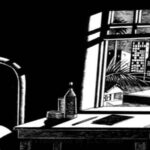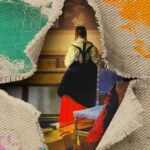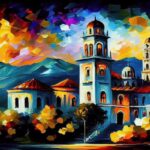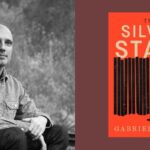Dead Dogs, Evil Eyes, and Writing the Ugly
Francesca DeMusz and Stacy Szymaszek in Conversation
Isn’t it illuminating to read someone’s personal interpretations of the goings-on in their life? Stacy Szymaszek’s Journal of Ugly Sites and Other Journals shies away from nothing, an active text striving for total self-honesty, repair, and an understanding of time beyond the linear sense all while facing the abjections of loss and death up close. Here, Szymaszek reveals what made these intense poems of the every-day possible.
Francesca DeMusz: These lines stayed with me throughout the whole book: “dog-friendly / markets that summer / went blotto / omen any / good Sicilian / would read.” Maybe because I’m Sicilian too, maybe because being introduced to an omen so early in the book leaves one waiting for the worst just like it should. As I worked through the book thinking about those lines, I started to qualify the way I’d call Journal for Ugly Sites & Other Journals a death-facing collection. Not in a morbid or overly sentimental way, it turns toward all of the abject, “ugly,” hard to swallow bits of mortality (blood, shit, discarded chicken bones in the street) with a sense of surrender and a little humor. I’m thinking of you and K “joking that this is the easiest it has ever been walking her” while carrying your dog Cass’s ashes into Mile End. It all started to remind me of my mom’s outlook on life. She’s Sicilian. Do you think that the acceptance of and surrender to the ugly without any attempt to romanticize it in sections like “austerity measures” and “journal of ugly sites” is informed by your Sicilian heritage? I realize I could ask instead if it’s an activist thing or a poet thing or a lesbian thing to look deep into the abject, upsetting parts of life and (try to) embrace them, so maybe a better question is: what did you draw on to keep this up? What experience leads itself to this kind of “outlook” or “attitude” or “mode” of dealing with the ugly?
Stacy Szymaszek: I feel like I could write my autobiography in response to this question! To start broadly, my connection to my mother and my Sicilian heritage is deep and influential. I talk to my mom every Sunday, and the general structure of these calls is that she reports bad news and I receive it. Or, in some cases, she retells old bad news. She was, of course, very protective of her children and let us know, particularly me because I was “different,” that danger lurked everywhere. When we moved into a new neighborhood when I was in 3rd grade, there was a boy who was found murdered nearby. It was seared into my consciousness that children could die. These were real-life dangers to be sure, but they were also inflected with superstition. If things are going well, I become preoccupied with trying to predict where and when the other shoe is going to drop. I learned to organize my internal world in this way where I felt I had some control, a fantasy of omnipotence. My renunciation of this control is on some level about repair, as well as surrender to absurdity.
Perhaps, through writing the book, I was also surrendering a part of my connection to my mother, and hoping to make room for something more joyful. You know the Maloik (evil eye) and the protection against it, wearing the cornuto? I frequently walk by a jewelry shop that has a very ostentatious one in the display window. I desire this object because it’s so absurd but then I don’t buy it because, well, I don’t buy it anymore! That the omen “shit on my shorts” appears early in the book wasn’t an intentional editorial decision as the pieces in the book appear chronologically—the events that unfold are real life. I wanted to stay on a diurnal rhythm to see what kind of repetitions would be pronounced. Sadly, two dogs die, one unexpectedly, and one got sick so soon after we rescued her that we basically provided hospice for her. The loss of the first dog fucked me up in ways that remain untold in the poems but the book is a response, even a reaction, to that death and a way of confronting sickness and mortality, which are just a matter of time for all of us. Someone recently said to me “I love that you put an ugly picture of yourself on the cover,” which is a hilarious complement that just seemed to sum it all up.
FD: I do know the Maloik and the cornuto. I love how another protection against the evil eye is the evil eye itself, it’s a culture of watching out. These practices are so defensive and the constant vigilance they require is a major stressor. So I see the real need not just to surrender but to repair—which reminds me of something I was thinking about the journaling practice. There are so many different types of journaling going on in this collection: bits of food diaries, note taking during therapy sessions, writing down symptoms to pin down a condition, keeping track of Cass’s tumor, etc. Would you say that these modes of journaling are self-help practices? Would you call this collection an attempt at self-help?
SS: I would agree with that. It’s an attempt that succeeded for me. I read a lot of self-help books as a teenager and I still do from time to time. Some of the titles made it into the journal, such as Thyroid Revolution and Can Love Last? My parents had a copy of I’m OK, You’re OK, which is apparently the best selling self-help book ever. I have this longtime identification with failure. My book helped me more than all the self-help books I’ve read. I finished writing “Journal of Ugly Sites” in July 2013 with the line “a newborn untethering at midnight.” I just realized that I started my next book, A Year From Today, nine months later in April 2014. I felt freer, which I think manifested itself formally. Journal of Ugly Sites & Other Journals starts spare and painterly and ends with a very visually ugly poem. So in A Year From Today I wanted to use the page in a way I hadn’t before, and what I ended up with feels beautiful and robust, similar to what I see in Paul Blackburn’s The Journals.
FD: There are so many coincidences with time in this collection, which only looking back on a journal can make clear. In thinking about the art-making of JOUS & Other Journals, I was reminded of Dorothy Iannone’s works collected in You Who Read Me With Passion Now Must Forever Be My Friends. Both books read as somewhat tossed off or automatic and close to life. As you said above “the events that unfold are real life.” I think that quote is equally true of Iannone’s work. Her drawings are journalistic in a way (and so fun). I remember the moment in “summer journal [2012]” where you write “asked if I’m / working or fucking / around // ‘whats the diff?'” I feel like that’s such an artist’s/poet’s perspective, and with the journals presented in chronological order I wonder what the editing process was like for this collection. Can you talk about the “work” of it?
SS: I don’t know Dorothy Iannone’s work but will check out that book. I remember somewhere nearing the end of writing the poem “Journal of Ugly Sites,” looking back at everything I had written since I completed hart island, and realizing that they were all journals, that they all made sense together in a book. Then I saw the Fence call and put them all into one document and quickly submitted them. It felt strangely instinctive. To answer your question about editing, all of the work minus “Journal of Ugly Sites” was barely to not edited. “JOUS” was a monster. I had never written a poem with so many words. In July, the last month of writing it, I decided I had to go back and use gerunds. I hate gerunds in poems, but I came across a Bernadette Mayer line about the gerund “as a space for existing” and that made great sense to me for this piece. It was an intense, last minute, change of heart—if I was going to write another book I needed to use language to create more space for existing. And then I did write another book because of that—“Ugly” is kind of the theory and A Year From Today is the practice.
So, I went back and just starting adding “-ing” to hundreds of words without really being sure if I was making gerunds or present participles. It felt like I was making a mess of things. I looked to Gail Scott’s My Paris as a guide though, for confidence to maintain some of the unusual syntax that arose. Brenda Hillman, the Ottoline contest judge, gave me simple but important feedback, which was to make cuts where the language had gotten more slack or dull, which is truly not a problem I had ever had before—but this was the first time I was trying to “include everything.”
Rebecca Wolff at Fence had a “global” editorial suggestion, which had to do with those rascally gerunds. I used “being” about 100 times, as in “animal heaven being called the ‘rainbow bridge’”—really unnecessary. I was carrying around Mayer’s book Moving (a gerund, a good omen) in my bag when I wrote “5 days 4 nights,” intending to read it, that’s noted in the poem, but in retrospect it was more of a talisman since I ended up reading fashion magazines!
FD: That’s a beautiful, collaborative process. And the more I hear about this book’s coming into being, the more mystical it sounds. There’s a pronounced reprieve found in “5 days 4 nights,” and a strong motif of reverting or regressing, mentions of “muscle memory” and the great line “regression can / be lovely if not horrific.” There is a different sense of family there too, one of distanced intimacy, kindness and giving people a pass: “I leave them alone life long / Catholics I never / have a comeback.” Can you talk more about this section and your decision to include it in the collection?
SS: Though I don’t use the word “mystical’ to think about my process, I know what you mean and want to say more about it. My attention to the everyday, through the medium of poetry, and the journal form, is meant to punch holes in the traditional notion of time as linear. Time really bewilders me—that I exist, that people live and die… One of my favorite poets Philip Whalen said: “This poetry is a picture or graph of a mind moving, which is a world body being here and now which is history… and you.” And also, “I just want to wreck your mind.” We all know that our minds don’t function in a linear way. One of the most surprising things about getting older, for me, has been its impact on my relationship to time. There are certain moments in my life where I’ve had to situate myself in the past or the present or the future, but currently, I feel the coursing and bending of being in all places at once. I just came across this Toni Morrison quote which I love: “We die. That may be the meaning of life. But we do language. That may be the measure of our lives.” I’m not saying I’m some kind of wizard!—in fact, I just think this is probably completely mundane, to feel my function as a poet in this particular way.
The poem “5 days 4 nights” is not a comfortable inclusion for me, yet there it is. It’s not comfortable because it documents a visit with my family and, as you say, has this regression motif—or, my attempt not to regress into old dynamics. There’s vulnerability there. The “passes” go both ways. I started writing it at LaGuardia in a somewhat conscious attempt to go in with my poet identity in full force to bolster me, like I was on assignment! I never thought not to include it, and I like how it functions in the book, as a middle, and as part of a formal expansion that leads to the explosiveness of the ugly journal. It also affirms Milwaukee as another space where I trod, as do parts of “austerity measures.” My mom always asks, “will we understand this one?” and I say yes these next two, you will. I was in Paris contemplating how to give my mom the book, what I would say. By the time I got back from Paris she had ordered it online and read it. She said she was depressed all day and wondered why and then thought “oh, that book.” She doesn’t like thinking about her kid having a hard time in NYC. On the other hand, Rebecca Wolff, when introducing me recently, said the temptation of the book was that one would come away “believing that they knew Stacy.” I thought that was insightful. It is, above all, a work of art.
FD: It’s a funny kind of wizard to be I guess, to lay things out as they are, the mundane, the things many people take for granted like time and death and language, and see what’s there. Whether or not it’s mystical or mundane I’m not sure now, but it does remind me of reading the Tarot.
I’m glad that a piece like “5 days, 4 nights” can come out of the impulse to prepare for going back but not exactly regressing. I’m reading Dorothy Allison’s Skin right now. She writes about the anxiety of bringing a lover to meet her family, but also about her other (queer, lesbian) families in Brooklyn. In “Two Faggots, Twenty Dykes and a Whole Lot of Barbeque” a bunch of queers visit Allison on Labor day to help fix up the decrepit old house into which she and her girlfriend had recently moved. It sounded so dreamy to me, but I was glad I could check my nostalgia thinking of your lines: “passing Cubby Hole used to come to NYC to go to gay clubs and Pride moving here stopped going to gay clubs and Pride” and “flashback to Valentine’s Day at Clit Club me alone in leather a voyeur a night of life me being most grateful for.” What did you see in leather at Clit Club on Vday (or any day)? How have you watched NYC change for queers and/or how has your queer relationship with NYC changed?
SS: For most of my life I felt that I only had one family and that was my biological family. Now my partner, Kathleen, is my family too, and a third dog. I moved far away from my bio family when I was 22 and had a very specific idea of what my life was going to be like based on this, I think, nostalgic idea of creating my dyke family. I realize that many people succeed at this, and that it’s a powerful narrative. But I was on the shadow side of that narrative as a fairly traumatized person who sucked at relationships, even friendship. How could I possibly build an alternate family? I ventured to NYC by myself for the first time in 1990. I had a second cousin who lived in Midtown so I stayed with her. I basically walked around downtown buying clothes and hats, leaving the stores wearing them, eating in Little Italy, and going to dyke bars. My night at the Clit Club felt like I was watching women who were having erotic fun together. They seemed fearless but maybe I was fearless too, being there alone, displaying my aloneness. NYC is where I feel at home as a lesbian, so in that sense this is my only home. Queerness and all aside, it currently feels like an unfolding crisis to me. Is community becoming something for those with time and money (and energy)—that’s a terrifying implosion. Exhaustion makes it hard to sustain and deepen friendships, which is so challenging to do anyway, and to write. I’m trying to invent ways to get more of what I need here, more space for living. Part of that is staying open to what NYC is so emblematic of—unexpected possibility. One of the sustaining aspects of my job at The Poetry Project is meeting and often befriending so many brilliant people at different stages in their lives, some quite young and some very old. As a middle-aged person, I find this inter-generationality and in-person time vital.
Image: The Evil Eye, John Phillip, 1859.




















